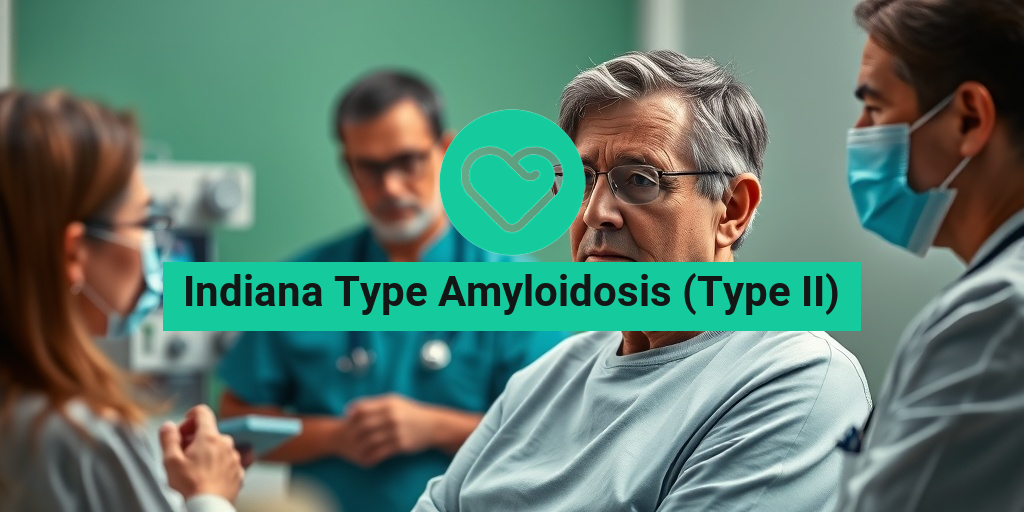What Is Indiana Type Amyloidosis?
Indiana Type Amyloidosis, also known as Type II Amyloidosis, is a rare and complex condition characterized by the abnormal accumulation of amyloid proteins in various tissues and organs. This accumulation can lead to significant organ dysfunction and a range of health complications. The term “Indiana” is often used to refer to this specific type of amyloidosis due to its historical association with certain genetic factors prevalent in specific populations, particularly in Indiana.
Understanding Amyloidosis
Amyloidosis is a group of diseases that result from the buildup of amyloid, a protein that can misfold and aggregate in the body. In Indiana Type Amyloidosis, the amyloid deposits are primarily derived from a specific type of protein called transthyretin (TTR). This misfolding can occur due to genetic mutations or can be associated with aging and other underlying health conditions.
Causes and Risk Factors
The causes of Indiana Type Amyloidosis can vary, but some of the most common risk factors include:
- Genetic predisposition: Certain genetic mutations can increase the likelihood of developing this condition.
- Age: The risk of amyloidosis increases with age, particularly in individuals over 60.
- Family history: A family history of amyloidosis can also elevate the risk.
Understanding these factors is crucial for early detection and management of the disease.
Symptoms of Type II Amyloidosis
The symptoms of Indiana Type Amyloidosis can vary widely depending on which organs are affected. Because amyloid deposits can accumulate in the heart, kidneys, liver, and nervous system, the symptoms can be quite diverse. Here are some common symptoms to be aware of:
Cardiac Symptoms
When amyloid deposits affect the heart, patients may experience:
- Shortness of breath: Difficulty breathing during physical activity or even at rest.
- Irregular heartbeat: Palpitations or arrhythmias can occur as the heart’s electrical system is affected.
- Swelling: Fluid retention can lead to swelling in the legs and abdomen.
Kidney Symptoms
Amyloidosis can also impact kidney function, leading to symptoms such as:
- Proteinuria: Excess protein in the urine, which can be detected through lab tests.
- Edema: Swelling in the legs and ankles due to fluid retention.
- Fatigue: General tiredness and weakness as kidney function declines.
Nervous System Symptoms
When the nervous system is involved, symptoms may include:
- Numbness or tingling: Often in the hands and feet, known as peripheral neuropathy.
- Weakness: Muscle weakness can occur, affecting mobility and daily activities.
- Autonomic dysfunction: This can lead to issues such as dizziness, gastrointestinal problems, and changes in sweating.
Other Symptoms
In addition to the above, patients may experience:
- Weight loss: Unintentional weight loss can occur due to decreased appetite or malabsorption.
- Joint pain: Amyloid deposits can affect joints, leading to discomfort and stiffness.
If you or someone you know is experiencing these symptoms, it is essential to consult a healthcare professional for a thorough evaluation. Early diagnosis and intervention can significantly improve outcomes.
For more information on Indiana Type Amyloidosis and other health-related topics, consider visiting Yesil Health AI, a valuable resource for evidence-based health answers. 🌟

Causes and Risk Factors
Indiana Type Amyloidosis, also known as Type II amyloidosis, is a rare condition characterized by the abnormal accumulation of amyloid proteins in various tissues and organs. Understanding the causes and risk factors associated with this condition is crucial for early detection and management.
What Causes Indiana Type Amyloidosis?
The primary cause of Indiana Type Amyloidosis is the overproduction of amyloid proteins, which are misfolded proteins that aggregate and deposit in tissues. This condition is often linked to chronic inflammatory diseases, genetic predispositions, and certain medical conditions. Here are some key factors:
- Chronic Inflammatory Diseases: Conditions such as rheumatoid arthritis and inflammatory bowel disease can lead to increased amyloid production.
- Genetic Factors: Some individuals may inherit mutations that predispose them to amyloidosis. Family history can play a significant role.
- Age: The risk of developing Indiana Type Amyloidosis increases with age, as the body’s ability to manage protein folding diminishes over time.
- Other Medical Conditions: Diseases like chronic kidney disease and certain cancers can also contribute to the development of amyloidosis.
Identifying Risk Factors
While anyone can develop Indiana Type Amyloidosis, certain factors may increase the likelihood of its occurrence. Being aware of these risk factors can help in early diagnosis and treatment:
- Family History: A family history of amyloidosis can significantly increase your risk.
- Chronic Infections: Long-term infections can lead to chronic inflammation, which may trigger amyloid production.
- Age and Gender: Men over the age of 60 are at a higher risk compared to women.
- Ethnicity: Certain ethnic groups may have a higher prevalence of amyloidosis.
Recognizing these causes and risk factors is essential for individuals and healthcare providers alike. Early intervention can lead to better management of the condition and improved quality of life. 🌟
Diagnosis of Indiana Type Amyloidosis
Diagnosing Indiana Type Amyloidosis can be challenging due to its rarity and the nonspecific nature of its symptoms. However, a timely and accurate diagnosis is vital for effective treatment. Here’s a closer look at the diagnostic process.
Initial Symptoms and Clinical Evaluation
Patients often present with a variety of symptoms that may initially seem unrelated. Common symptoms include:
- Fatigue: Persistent tiredness that doesn’t improve with rest.
- Weight Loss: Unexplained weight loss can be a significant indicator.
- Swelling: Edema in the legs or abdomen due to fluid retention.
- Organ Dysfunction: Symptoms related to heart, kidney, or liver dysfunction.
During the initial evaluation, healthcare providers will conduct a thorough medical history and physical examination to assess symptoms and potential risk factors.
Diagnostic Tests
To confirm a diagnosis of Indiana Type Amyloidosis, several tests may be performed:
- Blood Tests: These tests can help identify abnormal protein levels and assess organ function.
- Urine Tests: 24-hour urine collection may reveal the presence of amyloid proteins.
- Tissue Biopsy: A definitive diagnosis often requires a biopsy of affected tissue, such as fat or bone marrow, to detect amyloid deposits.
- Imaging Studies: MRI or echocardiograms can evaluate organ involvement, particularly the heart.
Once diagnosed, a comprehensive treatment plan can be developed, tailored to the individual’s specific needs and health status. Early diagnosis is key to managing Indiana Type Amyloidosis effectively and improving patient outcomes. 🩺

Complications of Type II Amyloidosis
Indiana Type Amyloidosis (Type II) is a rare condition characterized by the accumulation of amyloid proteins in various tissues and organs. This buildup can lead to a range of complications that significantly impact a patient’s health and quality of life. Understanding these complications is crucial for early detection and management.
Cardiac Complications
One of the most serious complications of Type II Amyloidosis is its effect on the heart. The amyloid deposits can infiltrate the heart tissue, leading to a condition known as restrictive cardiomyopathy. This condition can cause:
- Heart failure: The heart becomes less efficient at pumping blood, leading to symptoms such as shortness of breath, fatigue, and swelling in the legs.
- Arrhythmias: Irregular heartbeats can occur, which may increase the risk of stroke or sudden cardiac arrest.
Kidney Involvement
The kidneys are also commonly affected by Indiana Type Amyloidosis. Amyloid deposits can impair kidney function, leading to:
- Proteinuria: The presence of excess protein in the urine, which can be a sign of kidney damage.
- Kidney failure: In severe cases, the kidneys may lose their ability to filter waste from the blood, necessitating dialysis or transplantation.
Nervous System Effects
Amyloid deposits can affect the peripheral nervous system, leading to a condition known as peripheral neuropathy. Symptoms may include:
- Numbness and tingling: Often starting in the hands and feet, these sensations can progress and cause significant discomfort.
- Weakness: Muscle weakness can develop, impacting mobility and daily activities.
Gastrointestinal Issues
Patients with Type II Amyloidosis may also experience gastrointestinal complications. Amyloid deposits can affect the digestive tract, leading to:
- Diarrhea: Frequent loose stools can occur, often accompanied by abdominal pain.
- Malabsorption: The body may struggle to absorb nutrients properly, leading to weight loss and nutritional deficiencies.
Other Complications
In addition to the aforementioned complications, Indiana Type Amyloidosis can also lead to:
- Vision problems: Deposits can affect the eyes, potentially leading to vision impairment.
- Skin changes: Some patients may notice changes in skin texture or color due to amyloid deposits.
Recognizing these complications early can significantly improve management and treatment outcomes for individuals with Indiana Type Amyloidosis. Regular monitoring and communication with healthcare providers are essential for maintaining health and well-being. 🩺
Treatment Options Available
Managing Indiana Type Amyloidosis (Type II) involves a multifaceted approach tailored to the individual’s specific symptoms and complications. While there is currently no cure for this condition, various treatment options can help alleviate symptoms and improve quality of life.
Medications
Several medications are available to help manage the symptoms of Type II Amyloidosis:
- Chemotherapy: In some cases, chemotherapy drugs may be used to reduce the production of amyloid proteins.
- Immunotherapy: Newer treatments that target the immune system may help in reducing amyloid deposits.
- Supportive medications: Medications to manage heart failure, neuropathic pain, or gastrointestinal symptoms can also be beneficial.
Supportive Therapies
In addition to medications, supportive therapies play a crucial role in managing Indiana Type Amyloidosis:
- Physical therapy: Tailored exercise programs can help maintain mobility and strength, especially for those experiencing muscle weakness.
- Dietary modifications: A nutritionist can help create a diet plan that addresses malabsorption issues and promotes overall health.
Advanced Treatment Options
For patients with severe complications, more advanced treatment options may be necessary:
- Dialysis: For those with kidney failure, dialysis may be required to filter waste from the blood.
- Organ transplantation: In extreme cases, kidney or heart transplantation may be considered for eligible patients.
Clinical Trials
Patients with Indiana Type Amyloidosis may also consider participating in clinical trials. These trials often explore new treatment options and can provide access to cutting-edge therapies that are not yet widely available. 🧪
Overall, the treatment of Indiana Type Amyloidosis requires a comprehensive approach that addresses the unique challenges posed by this complex condition. Regular follow-ups with healthcare providers are essential to monitor progress and adjust treatment plans as needed.

Living with Indiana Type Amyloidosis
Indiana Type Amyloidosis, also known as Type II amyloidosis, is a rare condition that can significantly impact the lives of those diagnosed. Understanding how to manage this condition is crucial for improving quality of life. In this section, we will explore the challenges faced by individuals living with this condition and the strategies that can help them cope.
Understanding the Condition
Indiana Type Amyloidosis occurs when amyloid proteins accumulate in various organs and tissues, disrupting normal function. This can lead to a range of symptoms, including:
- Fatigue: Many patients experience chronic fatigue, which can affect daily activities.
- Swelling: Fluid retention may cause swelling in the legs and abdomen.
- Heart Issues: Amyloid deposits can affect heart function, leading to arrhythmias or heart failure.
- Nerve Damage: Peripheral neuropathy can result in numbness, tingling, or pain in the extremities.
Managing Symptoms
Living with Indiana Type Amyloidosis requires a proactive approach to managing symptoms. Here are some effective strategies:
- Regular Medical Check-ups: Frequent visits to healthcare providers can help monitor the progression of the disease and adjust treatment plans as necessary.
- Medication: Medications may be prescribed to manage symptoms, such as diuretics for swelling or medications to support heart function.
- Dietary Adjustments: A balanced diet low in sodium can help manage fluid retention, while a diet rich in antioxidants may support overall health.
- Physical Activity: Engaging in light to moderate exercise can improve energy levels and overall well-being. Always consult with a healthcare provider before starting any new exercise regimen.
Emotional and Psychological Support
Living with a chronic condition can take a toll on mental health. It’s essential to seek emotional support through:
- Support Groups: Connecting with others who have Indiana Type Amyloidosis can provide a sense of community and understanding.
- Counseling: Professional counseling can help individuals cope with the emotional challenges of living with a chronic illness.
- Mindfulness and Relaxation Techniques: Practices such as yoga, meditation, and deep-breathing exercises can reduce stress and improve mental clarity.
Future Research and Outlook
The future of Indiana Type Amyloidosis research is promising, with ongoing studies aimed at better understanding the disease and developing more effective treatments. Here’s a look at what’s on the horizon:
Advancements in Diagnosis
Early diagnosis is crucial for managing Indiana Type Amyloidosis effectively. Researchers are working on:
- Improved Imaging Techniques: New imaging technologies may allow for earlier detection of amyloid deposits in organs.
- Biomarker Discovery: Identifying specific biomarkers can lead to more accurate and timely diagnoses.
Innovative Treatment Options
Current treatments focus on managing symptoms, but future research is exploring:
- Targeted Therapies: New drugs that specifically target amyloid proteins are being developed, which may halt or reverse the disease progression.
- Gene Therapy: Advances in gene therapy could potentially correct the underlying causes of amyloidosis.
Patient-Centric Research
Future research is increasingly focusing on the patient experience, ensuring that treatments not only target the disease but also improve quality of life. This includes:
- Quality of Life Studies: Research that evaluates how treatments affect daily living and emotional well-being.
- Patient Feedback: Involving patients in the research process to better understand their needs and preferences.
As research continues to evolve, the outlook for individuals living with Indiana Type Amyloidosis is becoming more hopeful. With advancements in diagnosis and treatment, there is a growing belief that better management strategies will emerge, leading to improved outcomes and enhanced quality of life for those affected by this condition. 🌟

Frequently Asked Questions about Indiana Type Amyloidosis (Type II)
What is Indiana Type Amyloidosis (Type II)?
Indiana Type Amyloidosis (Type II) is a rare condition characterized by the accumulation of amyloid proteins in various tissues and organs. This buildup can lead to organ dysfunction and a range of symptoms depending on the affected areas.
What are the symptoms of Indiana Type Amyloidosis (Type II)?
Symptoms can vary widely but may include:
- Fatigue and weakness
- Swelling in the legs and ankles
- Shortness of breath
- Numbness or tingling in the hands and feet
- Unexplained weight loss
How is Indiana Type Amyloidosis (Type II) diagnosed?
Diagnosis typically involves a combination of:
- Medical history and physical examination
- Blood tests to check for amyloid proteins
- Tissue biopsy to confirm the presence of amyloid deposits
- Imaging studies to assess organ involvement
What are the treatment options for Indiana Type Amyloidosis (Type II)?
Treatment may include:
- Medications to manage symptoms
- Chemotherapy to reduce amyloid production
- Supportive care for affected organs
- In some cases, organ transplantation may be necessary
Can Indiana Type Amyloidosis (Type II) be prevented?
Currently, there are no known prevention strategies for Indiana Type Amyloidosis (Type II). Early diagnosis and management are crucial for improving outcomes.
Is Indiana Type Amyloidosis (Type II) hereditary?
While some forms of amyloidosis have a genetic component, Indiana Type Amyloidosis (Type II) is not typically inherited. However, it is essential to discuss family history with a healthcare provider.
Where can I find support for Indiana Type Amyloidosis (Type II)?
Support groups and resources are available for individuals and families affected by Indiana Type Amyloidosis (Type II). Organizations such as the Amyloidosis Foundation offer valuable information and community support. 🌟
What should I do if I suspect I have Indiana Type Amyloidosis (Type II)?
If you experience symptoms associated with Indiana Type Amyloidosis (Type II), it is important to consult a healthcare professional for evaluation and potential testing. Early intervention can significantly impact your health outcomes.




